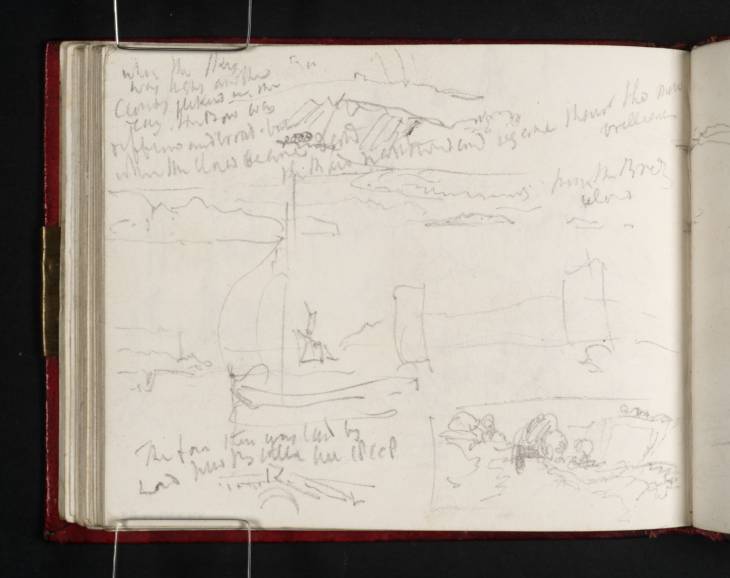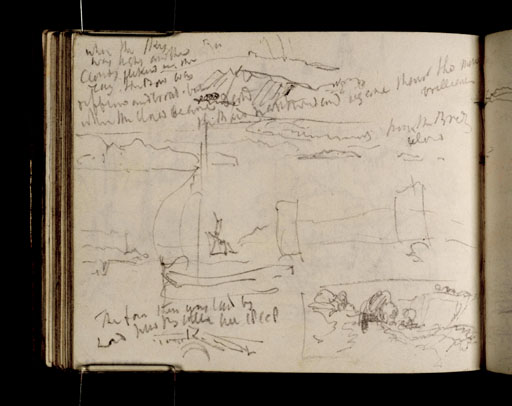Joseph Mallord William Turner A Bridge, a Study of Sky and Vessels Passing Castle on Promontory 1818
Image 1 of 2
Joseph Mallord William Turner,
A Bridge, a Study of Sky and Vessels Passing Castle on Promontory
1818
Joseph Mallord William Turner 1775–1851
Folio 52 Verso:
A Bridge, a Study of Sky and Vessels Passing Castle on Promontory 1818
D13552
Turner Bequest CLXVI 52 a
Turner Bequest CLXVI 52 a
Pencil on white wove paper, 90 x 112 mm
Inscribed in pencil by Turner across the page
Inscribed in pencil by Turner across the page
Accepted by the nation as part of the Turner Bequest 1856
References
1909
A.J. Finberg, A Complete Inventory of the Drawings of the Turner Bequest, London 1909, vol.I, p.483, CLXVI 52a, as ‘A bridge, “The four (?) stone was laid by Lord New Battle, in 1818,” a study of sky and vessels passing castle on promontory.’.
1969
John Gage, Colour in Turner: Poetry and Truth, London 1969, p.251 note 206.
2006
Andrew Wilton, Turner as Draughtsman, Aldershot 2006, p.148 chapter 3 note 47 as CLXVII [sic] 52 verso.
The three inscriptions on this page read as follows.
‘When the sky | Was light and the | Clouds [?] flickered in the | Ray, the Bow was | [?]diffuse and broad but | When the cloud Became [?]Dark | the Bow narrowed and became ?then the more | brilliant’ across the top of the page.
‘from the bridge | ?west’ at the upper right.
‘The four stone was laid by | Lord New Battle in 1818’ at the bottom left.
There are a number of sketches across this and the next page (folio 53; D13553) among which the most prominent is a sketch of shipping on what is presumably the Firth of Forth. There is also a slight sketch of the arch of a bridge at the bottom left of the present folio with an inscription, and on the right a thumbnail sketch of a landscape with a cliff-edge and trees. At the top of this folio is a rough and incomprehensible sketch covered by a long inscription. On the continuing page (folio 53) are four sketches of what Finberg describes as a ‘Castle on [a] Promontory’.1
The sketch of shipping continues an interest in this sketchbook in sailing vessels both moored and sailing near ports and harbours on the Firth of Forth (see Edinburgh, 1818 sketchbook Introduction). This sketch across 52 verso–53 shows five vessels, one of which, on the far left, may be moored although its sail is still up. Both banks of the Forth are shown, and on the right is a fortified structure on what Finberg describes as a ‘promontory’, but resembles a drawing of the fortified island of Inchgarvie on folio 51 (D13549).
The sketch of the bridge, while not particularly distinctive in itself, has an interesting inscription which Finberg transcribed as, ‘The four (?) stone was laid by Lord New Battle in 1818’.2 According to this reading, Turner seems to be referring to an event, which he perhaps witnessed, when a stone, presumably of the bridge depicted beneath, was ceremonially laid by ‘Lord New Battle’. Although he dropped the title in 1815, John William Robert Kerr, the Seventh Marquis of Lothian, had used the title Lord Newbattle, so it is possible that this is who Turner is referring to. There is another sketch of a bridge inscribed ‘New Battle Road’ on folio 36 of this sketchbook (Tate D13552; Turner Bequest CLXVI 36).
The long inscription at the top of the page has been transcribed by John Gage and understood as recording the changing appearance of a rainbow.3 The rough sketch over which this inscription is made may show the rainbow which was perhaps spotted in the cloudy sky over the Firth of Forth depicted below, or even seen over Crichton Castle as in the colour study Crichton Castle, with Rainbow, circa 1818 (watercolour, Yale Center for British Art),4 which was based on sketches from this tour.
Thomas Ardill
January 2008
How to cite
Thomas Ardill, ‘A Bridge, a Study of Sky and Vessels Passing Castle on Promontory 1818 by Joseph Mallord William Turner’, catalogue entry, January 2008, in David Blayney Brown (ed.), J.M.W. Turner: Sketchbooks, Drawings and Watercolours, Tate Research Publication, December 2012, https://www


